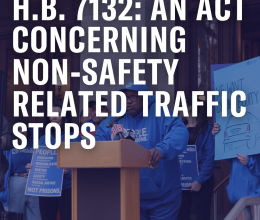Bill would change minor drug possession from a felony to misdemeanor, which 67 percent of Connecticut voters support
Ends wildly unpopular mandatory minimums for non-violent drug crimes, a move supported by 82 percent of Connecticut voters
Connecticut lawmakers are considering sweeping reforms that would keep non-violent, low-level drug offenders out of prison and establish common-sense programs to stop repeat offending.
Stephen Glassman, Executive Director of the American Civil Liberties Union of Connecticut, said, “From Austin to Albany the nation is focusing on fixing our overburdened, biased, and increasingly expensive criminal justice system. Here in Connecticut we can find more cost-effective, productive, and compassionate ways than prison to deal with people who need rehabilitation, counseling, training, and support. More important, fixing our broken criminal justice system will keep our communities safer once law enforcement resources are focused on the most serious crimes. As our prison population is now at a 16-year low, crime is already declining dramatically.”
The bill makes a number of improvements to the criminal justice system, including re-classifying simple possession of small amounts of drugs from a felony to a misdemeanor and eliminating mandatory minimum sentences for possession of drugs within 1,500 feet of a school or day care center—an unrealistic distance that disproportionately punishes Connecticut's urban residents.
The bill also establishes an expedited pardons review process for those convicted of non-violent crimes and increases the number of full-time members on the Board of Pardons and Paroles. The Governor also seeks to develop re-entry systems into communities throughout the state in order to reduce recidivism and halt our revolving door phenomenon.
A recent Quinnipiac poll found that 67 percent of Connecticut voters support reducing draconian penalties for small amounts of illegal drugs for personal use from a felony to a misdemeanor. By even greater margins, 82-to-15 percent, voters support eliminating harmful mandatory minimum sentences for small amounts of illegal drugs.
Connecticut Prison Fact Sheet:
- Between the late 1970s and the 2000s, the Connecticut state prison population exploded from less than a few thousand to almost 20,000 in 2008.
- As mass incarceration ballooned in our state, so did spending. Between 1999 and 2012, spending on prisons increased 178 percent, from $250-million to almost $700-million.
- Each prisoner represents a tremendous individual cost to Connecticut taxpayers, about $93 dollars per day or around $34,000 per year. According to one study, that $34,000 doesn't include employee benefits, pension contributions, debt reduction, and statewide administrative costs, which push the actual annual per-inmate bill up to of $50,262.
- The Connecticut Business & Industry Association (via the Pew Center on the States) estimates that if Connecticut reduced its recidivism rate by just 10 percent, the state would save $20 million per year.






